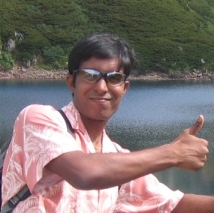
I attended the 38th annual conference of Society of Nuclear Medicine, India (SNMI) 2006 held from 13-16th December at Jamshedpur, in Jharkand, a northern state of India. Jamshedpur is well known as “Steel city of India” and the home of Tata conglomerates, popular worldwide for Tata steel, Tata motors, Tata Tea and many others. The conference was organized by Nuclear Medicine Department of Tata Main Hospital.
The theme of the conference was chosen to be “Basics….& the Best” to refresh basic principles governing nuclear medicine and highlight recent advances available to the medical fraternity.
The Scientific Programme started with the CME sessions on day 1 and followed by conference sessions for 3 days, which included orations, panel discussions, free papers and read-with-experts sessions. There were nearly 250 delegates including students, with experts coming from USA, UK and Brazil. Dr. Tiwari and I were the only representatives from Japan. There were 38 oral presentations in free paper sessions and 21 poster presentations.
The CME sessions covered recent technological advances in nuclear medicine, nuclear cardiology, brain tumors, pulmonary embolism, hepatobiliary imaging and renal hypertension. The talks were given by experts from both India and abroad. Dr. Sharmila Banerjee discussed about an indigenously produced 125I-sources for ocular or prostate cancer therapy. In the PET-CT section, Response evaluation criteria in solid tumors (RECIST) was highlighted. Dr. Dominique Delbeke, visiting faculty from USA gave a talk on current concepts of SPECT v/s PET v/s coronary CTA for applications in Nuclear cardiology. The significance of various established SPECT and PET tracers and the role of coronary calcium scoring were thoroughly elaborated. Dr. C.S. Bal of AIIMS delivered a lecture on Functional / Metabolic imaging in brain tumors where in he elucidated the availability of different clinical tracers for detection and staging of differential grade brain tumors. Dr. Harsh Mahajan of Mahajan Imaging Centers delivered lecture on usage of CT / MRI in evaluation of brain tumors with special emphasis on ultra-fast sequences, Diffusion tensor imaging (DTI) and MR tractography. Dr. BA Krishna of Hinduja Hospital highlighted the different hepatobiliary disorders that could be evaluated by HIDA scan.
The Homi Bhabha oration on 14th December was given by Dr. Anil Kakodkar, chairman of Atomic Energy Commission. He is a key figure in development of Nuclear energy in India. He commended the expanding application in peaceful uses of nuclear energy. Dr. Delbeke gave an elaborative talk on integrated FDG-PET and PET/CT for assessment of tumor biology where in she covered a range of tumors that can be structurally and functionally evaluated by latest imaging modality, the PET/CT. Her next talk focused on the application of FDG-PET and other tracers in infection and inflammatory diseases. Novel tracers like 67Ga-citrate, 111In and 99mTc labeled WBCs, labeled human Ig, antigranulocyte antibody and peptides were all mentioned for diagnosis and management of infections such as osteomyelitis, diabetic foot, HIV, FUO, arteritis, thrombophlebitis, acute pancreatitis and so on. In the evening, a quiz on nuclear medicine was held where in five teams each of 3-4 members participated. I along with Dr. Tiwari and Dr. Ponraj (junior from IIT Kharagpur) formed a team and were able to win runners-up prize.
The next day started with free paper session, where in Dr. Tiwari`s presentation was also scheduled. Most of the presenters were from India and elaborated their respective research works. Few interesting papers presented were the use of radiolabeled stem cells, preparation of 99Mo-99mTc generators and biodistribution studies of radiolabeled biotin vs gammaglobulin. My talk was scheduled for post lunch session under PET category. With the limited audience, there were not many questions raised for my presentation.
The final day had interesting presentation for Vikram Sarabhai oration from Dr. John Buscombe, a visiting faculty from UK. He briefed on radionuclide therapy such as Y-90 labeled tiuxetan ibrutumab for NHL, In-111 labeled Zevalin for follicular lymhoma, Radium-223 therapy for bone tumors and so on. Surprisingly in the valedictory function, mine and Dr. Tiwari`s names were announced to receive the awards for second-best presentations in our respective categories.
The enlightening academic sessions were followed each day by the evening cultural amusements of light music and drama.Finally, my perspective from the meeting is that a gradual but steady progress is ongoing in terms of PET and clinical nuclear medicine research with most of the major cities having hybrid PET/CT scanners. In near future, new installations of cyclotrons will likely happen and more number of nuclear medicine centers will actively participate to further advance this emerging field in medicine.
